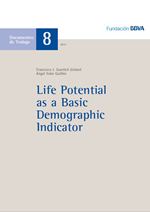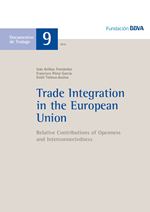The Ivie has coordinated working papers number 8 and 9 of 2012, published by the BBVA Foundation, "Life Potential as a Basic Demographic Indicator" and "Trade Integration in the European Union: Relative Contributions of Openness and Interconnectedness". These studies, along with other papers, are available on the
BBVA Foundation website.
Working paper no. 8/2012: Life Potential as a Basic Demographic Indicator

This working paper proposes an indicator that integrates life expectancy with the demographic structure of the population for a given society, combining the simple indicators of mortality and aging. Life expectancy at birth is independent of the demographic structure of the population and is, therefore, adequate for measuring overall mortality. However, it neglects to take into account the fact that life expectancy increases as society ages. We propose a simple indicator that integrates life expectancy at different ages, not only at birth, with the demographic structure of the population at a given point in time. The indicator has an intuitive interpretation in terms of the life potential, or biological capital, of society; and given that it is a weighted average, its changes can be easily decomposed into reductions in mortality (gains in life expectancy) and aging for different age intervals.
Francisco J. Goerlich is a researcher at the Ivie and professor at the University of Valencia and Ángel Soler is a technician research at the Ivie.
Working paper no. 9/2012: Trade Integration in the European Union: Relative Contributions of Openness and Interconnectedness

This working paper presents a set of indicators to measure regional trade integration, with a special focus on the case of the European Union. We propose measures of openness, connectedness and integration which are tuned to evaluate not only how these components contribute to the advance of international integration but also to control for the potential threat that the proliferation of regional trade agreements may pose to trade globalization. Although this and related questions have been examined from several perspectives, the present article combines the virtues of using a network analysis approach and the possibility to explicitly quantify how regional trade agreements either intensify or thwart international trade integration. Results show that the process of international trade integration has intensified among EU members, whereas trade integration with non-members is advancing slowly. Our indicators provide a more complete view of the differing speeds of integration, which depends on the component of integration considered —either openness or connectedness.
This working paper was carried out by Iván Arribas (Universitat de València), Francisco Pérez (Ivie and UV) and Emili Tortosa Ausina (Ivie and UJI).







 This working paper proposes an indicator that integrates life expectancy with the demographic structure of the population for a given society, combining the simple indicators of mortality and aging. Life expectancy at birth is independent of the demographic structure of the population and is, therefore, adequate for measuring overall mortality. However, it neglects to take into account the fact that life expectancy increases as society ages. We propose a simple indicator that integrates life expectancy at different ages, not only at birth, with the demographic structure of the population at a given point in time. The indicator has an intuitive interpretation in terms of the life potential, or biological capital, of society; and given that it is a weighted average, its changes can be easily decomposed into reductions in mortality (gains in life expectancy) and aging for different age intervals.
This working paper proposes an indicator that integrates life expectancy with the demographic structure of the population for a given society, combining the simple indicators of mortality and aging. Life expectancy at birth is independent of the demographic structure of the population and is, therefore, adequate for measuring overall mortality. However, it neglects to take into account the fact that life expectancy increases as society ages. We propose a simple indicator that integrates life expectancy at different ages, not only at birth, with the demographic structure of the population at a given point in time. The indicator has an intuitive interpretation in terms of the life potential, or biological capital, of society; and given that it is a weighted average, its changes can be easily decomposed into reductions in mortality (gains in life expectancy) and aging for different age intervals. This working paper presents a set of indicators to measure regional trade integration, with a special focus on the case of the European Union. We propose measures of openness, connectedness and integration which are tuned to evaluate not only how these components contribute to the advance of international integration but also to control for the potential threat that the proliferation of regional trade agreements may pose to trade globalization. Although this and related questions have been examined from several perspectives, the present article combines the virtues of using a network analysis approach and the possibility to explicitly quantify how regional trade agreements either intensify or thwart international trade integration. Results show that the process of international trade integration has intensified among EU members, whereas trade integration with non-members is advancing slowly. Our indicators provide a more complete view of the differing speeds of integration, which depends on the component of integration considered —either openness or connectedness.
This working paper presents a set of indicators to measure regional trade integration, with a special focus on the case of the European Union. We propose measures of openness, connectedness and integration which are tuned to evaluate not only how these components contribute to the advance of international integration but also to control for the potential threat that the proliferation of regional trade agreements may pose to trade globalization. Although this and related questions have been examined from several perspectives, the present article combines the virtues of using a network analysis approach and the possibility to explicitly quantify how regional trade agreements either intensify or thwart international trade integration. Results show that the process of international trade integration has intensified among EU members, whereas trade integration with non-members is advancing slowly. Our indicators provide a more complete view of the differing speeds of integration, which depends on the component of integration considered —either openness or connectedness.